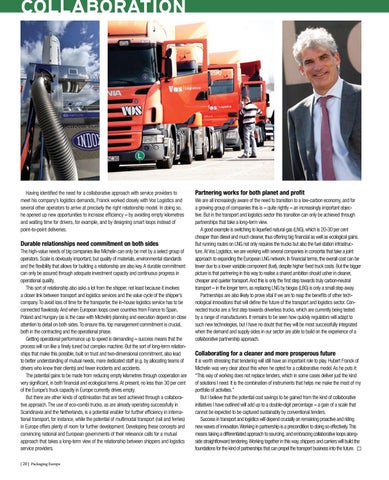Collaboration
Having identified the need for a collaborative approach with service providers to meet his company’s logistics demands, Franck worked closely with Vos Logistics and several other operators to arrive at precisely the right relationship model. In doing so, he opened up new opportunities to increase efficiency – by avoiding empty kilometres and waiting time for drivers, for example, and by designing smart loops instead of point-to-point deliveries.
Durable relationships need commitment on both sides The high-value needs of big companies like Michelin can only be met by a select group of operators. Scale is obviously important, but quality of materials, environmental standards and the flexibility that allows for building a relationship are also key. A durable commitment can only be assured through adequate investment capacity and continuous progress in operational quality. This sort of relationship also asks a lot from the shipper, not least because it involves a closer link between transport and logistics services and the value cycle of the shipper’s company. To avoid loss of time for the transporter, the in-house logistics service has to be connected flawlessly. And when European loops cover countries from France to Spain, Poland and Hungary (as is the case with Michelin) planning and execution depend on close attention to detail on both sides. To ensure this, top management commitment is crucial, both in the contracting and the operational phase. Getting operational performance up to speed is demanding – success means that the process will run like a finely tuned but complex machine. But the sort of long-term relationships that make this possible, built on trust and two-dimensional commitment, also lead to better understanding of mutual needs, more dedicated staff (e.g. by allocating teams of drivers who know their clients) and fewer incidents and accidents. The potential gains to be made from reducing empty kilometres through cooperation are very significant, in both financial and ecological terms. At present, no less than 30 per cent of the Europe’s truck capacity in Europe currently drives empty. But there are other kinds of optimisation that are best achieved through a collaborative approach. The use of eco-combi trucks, as are already operating successfully in Scandinavia and the Netherlands, is a potential enabler for further efficiency in international transport, for instance, while the potential of multimodal transport (rail and ferries) in Europe offers plenty of room for further development. Developing these concepts and convincing national and European governments of their relevance calls for a mutual approach that takes a long-term view of the relationship between shippers and logistics service providers. | 20 | Packaging Europe
Partnering works for both planet and profit We are all increasingly aware of the need to transition to a low-carbon economy, and for a growing group of companies this is – quite rightly – an increasingly important objective. But in the transport and logistics sector this transition can only be achieved through partnerships that take a long-term view. A good example is switching to liquefied natural gas (LNG), which is 20-30 per cent cheaper than diesel and much cleaner, thus offering big financial as well as ecological gains. But running routes on LNG not only requires the trucks but also the fuel station infrastructure. At Vos Logistics, we are working with several companies in consortia that take a joint approach to expanding the European LNG network. In financial terms, the overall cost can be lower due to a lower variable component (fuel), despite higher fixed truck costs. But the bigger picture is that partnering in this way to realise a shared ambition should usher in cleaner, cheaper and quieter transport. And this is only the first step towards truly carbon-neutral transport – in the longer term, as replacing LNG by biogas (LBG) is only a small step away. Partnerships are also likely to prove vital if we are to reap the benefits of other technological innovations that will define the future of the transport and logistics sector. Connected trucks are a first step towards driverless trucks, which are currently being tested by a range of manufacturers. It remains to be seen how quickly regulators will adapt to such new technologies, but I have no doubt that they will be most successfully integrated when the demand and supply sides in our sector are able to build on the experience of a collaborative partnership approach.
Collaborating for a cleaner and more prosperous future It is worth stressing that tendering will still have an important role to play. Hubert Franck of Michelin was very clear about this when he opted for a collaborative model. As he puts it: “This way of working does not replace tenders, which in some cases deliver just the kind of solutions I need. It is the combination of instruments that helps me make the most of my portfolio of activities.” But I believe that the potential cost savings to be gained from the kind of collaborative initiatives I have outlined will add up to a double-digit percentage – a gain of a scale that cannot be expected to be captured sustainably by conventional tenders. Success in transport and logistics will depend crucially on remaining proactive and riding new waves of innovation. Working in partnership is a precondition to doing so effectively. This means taking a differentiated approach to sourcing, and embracing collaborative loops alongside straightforward tendering. Working together in this way, shippers and carriers will build the foundations for the kind of partnerships that can propel the transport business into the future.
